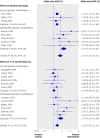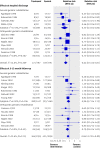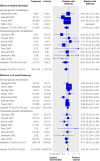Inpatient rehabilitation specifically designed for geriatric patients: systematic review and meta-analysis of randomised controlled trials
- PMID: 20406866
- PMCID: PMC2857746
- DOI: 10.1136/bmj.c1718
Inpatient rehabilitation specifically designed for geriatric patients: systematic review and meta-analysis of randomised controlled trials
Abstract
Objective: To assess the effects of inpatient rehabilitation specifically designed for geriatric patients compared with usual care on functional status, admissions to nursing homes, and mortality.
Design: Systematic review and meta-analysis.
Data sources: Medline, Embase, Cochrane database, and reference lists from published literature. Review methods Only randomised controlled trials were included. Trials had to report on inpatient rehabilitation and report at least one of functional improvement, admission to nursing homes, or mortality. Trials of consultation or outpatient services, trials including patients aged <55, trials of non-multidisciplinary rehabilitation, and trials without a control group receiving usual care were excluded. Data were double extracted. Odds ratios and relative risks with 95% confidence intervals were calculated.
Results: 17 trials with 4780 people comparing the effects of general or orthopaedic geriatric rehabilitation programmes with usual care were included. Meta-analyses of effects indicated an overall benefit in outcomes at discharge (odds ratio 1.75 (95% confidence interval 1.31 to 2.35) for function, relative risk 0.64 (0.51 to 0.81) for nursing home admission, relative risk 0.72 (0.55 to 0.95) for mortality) and at end of follow-up (1.36 (1.07 to 1.71), 0.84 (0.72 to 0.99), 0.87 (0.77 to 0.97), respectively). Limited data were available on impact on health care or cost. Compared with those in control groups, weighted mean length of hospital stay after randomisation was longer in patients allocated to general geriatric rehabilitation (24.5 v 15.1 days) and shorter in patients allocated to orthopaedic rehabilitation (24.6 v 28.9 days).
Conclusion: Inpatient rehabilitation specifically designed for geriatric patients has the potential to improve outcomes related to function, admission to nursing homes, and mortality. Insufficient data are available for defining characteristics and cost effectiveness of successful programmes.
Conflict of interest statement
Competing interests: All authors have completed the Unified Competing Interest form at
Figures




References
-
- WHO Expert Committee on Disability Prevention and Rehabilitation. Disability prevention and rehabilitation. World Health Organ Tech Rep Ser 1981;668:1-39. - PubMed
-
- Ottenbacher KJ, Smith PM, Illig SB, Linn RT, Ostir GV, Granger CV. Trends in length of stay, living setting, functional outcome, and mortality following medical rehabilitation. JAMA 2004;292:1687-95. - PubMed
-
- Huss A, Stuck AE, Rubenstein LZ, Egger M, Clough-Gorr KM. Multidimensional preventive home visit programs for community-dwelling older adults: a systematic review and meta-analysis of randomized controlled trials. J Gerontol A Biol Sci Med Sci 2008;63:298-307. - PubMed
-
- Rubenstein LZ, Josephson KR, Harker JO, Miller DK, Wieland D. The Sepulveda GEU Study revisited: long-term outcomes, use of services, and costs. Aging (Milano) 1995;7:212-7. - PubMed
